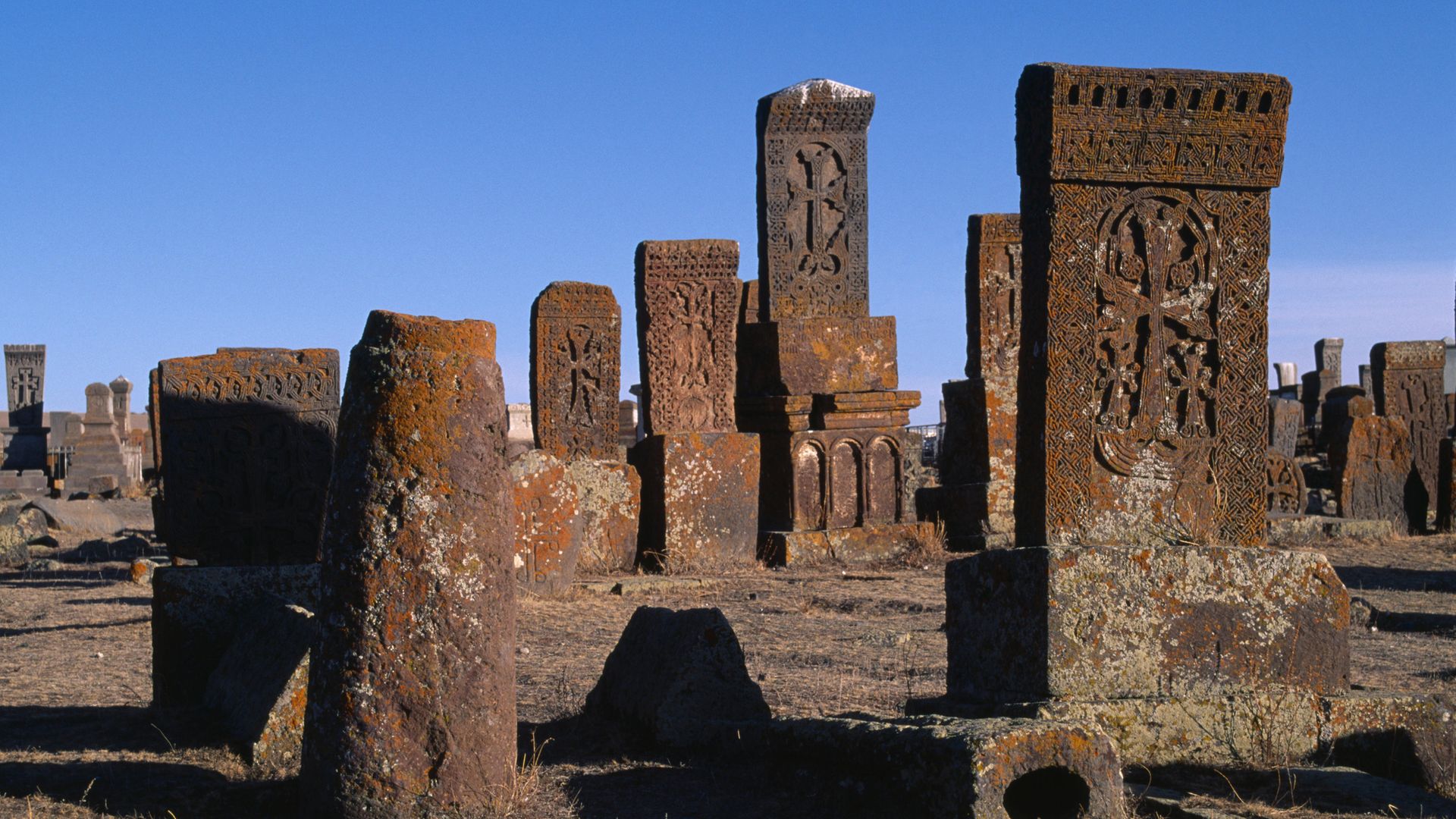
A light wind blew in off the water and combed the open grassland covering the hills rolling along above the lake. We’d visited the ruined monastery at Hayravank, wandering around the main body of the building – an octagonal drum surmounted by a conical dome – then exploring the overgrown outbuildings, poking into the shrubbery to discover toppled khachkars then running our fingers over their lichen-coated surfaces, feeling with our fingertips the intricate carving of vegetal and geometric motifs; the figures of friends… and foes. There’d been no other tourists there – just a few local people: an elderly woman selling candles to be lit in the monastery’s church, raffia crosses, and cups of muddy-black coffee. Now we were heading for the cemetery at Noratus, where there meant to be thousands of khachkars – the biggest extant repository of these ancient stelae, the carving of which dates from the 10th century.
I bumped the car off the metalled road and down a dirt track. Driving in these windswept grasslands felt more like navigation than any ordinary progress – an impression only heightened by the great milky-misty expanse of Lake Sevan; and beyond it, to the east, the mountains rising in successive ranges towards a long line of jagged peaks. We skirted a village, huddled behind crumbling masonry walls, and found the cemetery. Two middle-aged women, together with a younger man immediately materialised; the women were wearing long dresses, embroidered aprons and crocheted shawls – the young man was hunchbacked, his flapping trouser legs too short to cover his spindly shanks. He cavorted in the women’s train: a village idiot in a never-to-be-made Fellini film.
One of the women had a few words of English: she would show us the khachkars – while her companion did her best to sell us one of the other crocheted shawls she had draped over her arm. We saw khachkars carved in the 13th century, that showed the chariots of the Mongol invaders – and we saw khachkars carved when the country hereabouts was ruled by the Muslim Safavids, whose influence can be detected in the introduction of more obviously oriental decoration: complex geometric traceries in lieu of crosses and bearded figures. After a short while, the woman had exhausted her command of the lingua franca – and we’d bought the most intricately crocheted of the shawls. The women evaporated as suddenly as they’d manifested, while the young man stayed with us as we explored the rest of the cemetery, spinning on his stilt-legs, whistling and keening, wilder than the wind.
That was three years ago. We had thought of heading south, and taking the Lachin pass through Azerbaijani territory and into the disputed enclave of Nagorno-Karabakh – but the conflict which has exploded yet again in recent weeks between these two Transcaucasian nations was simmering even then, with the occasional driver succumbing to a bullet either stray, or aimed. Now, of course, I regret our timorousness: friends in Yerevan told us that the enclave was “the true Armenia” – but then that’s an ascription this most displaced of people cleave to with all of their considerable passion.
My partner is a daughter of the Armenian Diaspora, from a family line twice removed from Transcaucasia: first, many centuries ago, to Bursa in Turkey, where there was a large Armenian silk-weaving community – then, by reason of the genocide which began in 1915, to France. There’s a certain grotesquery to the Armenians’ desperation when it comes to the genocide: they’ve been known to complain that whereas the world’s attention remains fixed and unwavering on the Holocaust and its remembrance, the near-obliteration of some 1.5 million Turkish Armenians during and after the First World War has not only received scant attention internationally, but such is the nature of realpolitik, the West continues to give the Turks a free pass when it comes to rubbing their noses in the bloody deeds of their forefathers.
I’m not interested in entering the he-bombed, she-shelled of the resumed hostilities: both Armenians and Azerbaijanis have now been accused of launching attacks on each other’s territory beyond the disputed enclave, while both nations have a history of ruthlessness when it comes to purging the enclaves of the other’s people in their territory. Moreover, the instability of the region is indeed immemorial – as the khachkars memorialise: empires have risen and fallen; peoples have migrated hither and thither. No wonder it’s a mess. In the 20th century alone, the regional power, Russia, has sought to inflame hostilities so as to divide and rule on two major occasions: first during the collapse of the Romanov dynasty – then during the aftermath of the Soviet Union. And then there’s the matter of a personal connection – which cannot help but lead to bias of some sort.
Nevertheless, I will say this: imagine there was a German-speaking nation bordering Israel-Palestine, supported militarily by Germany itself. Furthermore, imagine that Germany had never acknowledged the Holocaust, while there was currently a right wing nationalist government in Berlin that made such denial an article of its ideological faith. Under such circumstances, if you were a Jew living in Israel-Palestine – or Golders Green for that matter – I expect you’d be feeling pretty nervous.










